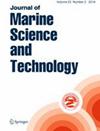综合海岸管理动态模型:以南苏拉威西岛Luwu和Palopo Regency Bone Bay水域海藻养殖为例
IF 2
4区 工程技术
Q2 ENGINEERING, CIVIL
引用次数: 0
摘要
棉真草海藻的携水能力应作为海藻最佳培养的考虑因素。承载力可以通过生态足迹(Ecological Footprint, EF)分析来确定,本研究采用的是生态足迹产量分析和平衡硝态氮分析。本研究以南苏拉威西岛鲁武和帕洛波地区2015年5月(第1过渡季)和2015年9月(第2过渡季)为研究对象。地图和土地利用分析与地理信息系统(GIS)。结果表明:泸沽湖流域生态足迹产量(EFP)为67.88 t /人均/年,折合235.82393 t /年;经分析,海草可利用水量为38.374.69公顷,可生产海草(生物承载力)为922.928.96吨/年,允许使用海草的养殖户为13.595人。Palopo水域的生态足迹产量(EFp)为3,08吨/人/年,相当于4,589,99吨/年。水资源可用性分析为979,82公顷,能够生产海藻(生物承载力)为10.115,34吨/年,允许使用该水域的农民人数为3.276人。基于鲁吴地区发展海藻养殖Eucheumacottonii的四种情景模拟管理结果和PalopoRegency以现有的废物投入为基础,将废物投入10%、25%和50%的水域产生不同的水域生物容量。生物承载力与生态足迹的比较结果表明,泸沽湖和八罗泊湖的生态状况仍处于可持续利用状态。模拟结果表明,在第二种情景下,在现有废物输入的基础上再增加10%,假设连续利用整个面积38.374.69公顷(以2008-2030年为尺度),产生的生物承载力最高的水量为8.257.274.94吨/年。因此,在第二种情况下对Palopo的海藻进行管理,假设整个面积的可用水量为979,82公顷,将产生最高的水域生物承载力为14.306,92吨/年。本文章由计算机程序翻译,如有差异,请以英文原文为准。
Integrated Coastal Management Dynamic Models: A Case Study of Development Seaweed Cultivation in the Waters Luwu and Palopo Regency Bone Bay, South Sulawesi
Waters carrying capacity in seaweed of Eucheuma cottonii cultures should be a concernforoptimum seaweed culture. Carryingcapacity can determine by Ecological Footprint (EF) analysis, which in this research usefootprint production, and mas balance nitrate analysis. This research on Mei 2015 (1sttransitionalseason) and September 2015 (2ndtransitionalseason) in Luwu and Palopo, South Sulawesi. Map and land use analyzed with geographic information systems (GIS).The results showed that theEcological Footprint production (EFP)in Luwu waters is 67,88 ton/capita/year, or equivalent to 235.823,93 tons/year.Based on the analysis of the availability of water for seaweed is 38.374,69 hectares, it can produce seaweed (biocapacity) for 922.928,96 tons/year and the number of farmers that allows for use the waters is 13.595 capita. The Ecological Footprint production (EFp) in Palopo waters is 3,08 ton/capita/year, or equivalent to 4.589,99 tons/year. Water availability analysis is 979,82 hectares are able to produce seaweed (biocapacity) for10.115,34 ton/year and the number of farmers that allows for use the waters is 3.276 capita. Based on the four scenario simulation management results of the development seaweed cultivation Eucheumacottonii in Luwu and PalopoRegency is based on the present waste input, pressing inputs of waste into the waters of 10%, 25% and 50% yield different waters biocapacity. The results comparison between biocapacity and Ecological Footprint, ecological status for Luwu and Palopo waters are still in sustainable use.Based on those simulation results showed that in second scenario by pressing the waste input by 10% from the existing waste input, as well as assuming the availability of water utilizing the entire area of 38.374,69 hectares continuously (on the years scale of 2008-2030), it will produce the highest biocapacity waters in the amount of 8.257.274,94 tons/year. So with the management of seaweed in Palopo with second scenario, assuming the availability of water utilizing the entire area of 979,82 hectares will produce the highest waters biocapacity of 14.306,92 tons/year.
求助全文
通过发布文献求助,成功后即可免费获取论文全文。
去求助
来源期刊

Journal of Marine Science and Technology
工程技术-工程:海洋
CiteScore
5.60
自引率
3.80%
发文量
47
审稿时长
7.5 months
期刊介绍:
The Journal of Marine Science and Technology (JMST), presently indexed in EI and SCI Expanded, publishes original, high-quality, peer-reviewed research papers on marine studies including engineering, pure and applied science, and technology. The full text of the published papers is also made accessible at the JMST website to allow a rapid circulation.
 求助内容:
求助内容: 应助结果提醒方式:
应助结果提醒方式:


